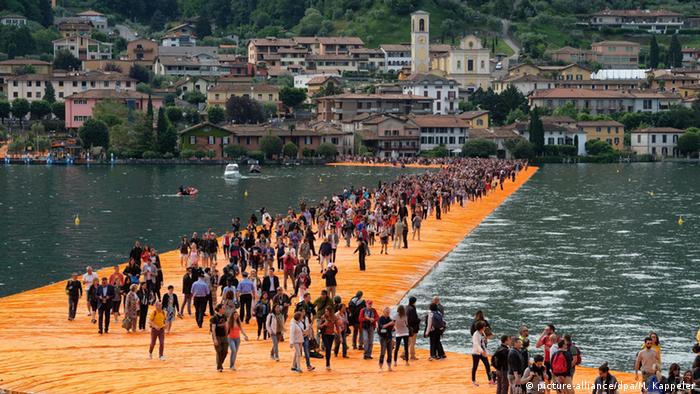Art
What remains of Christos Floating Piers?
Christos last of the great art of action “Floating Piers” at the Italian lake Iseo is also leaving its mark in Germany. However, the lost gradually in the truest sense of the word, “in the sand”.

The Floating Piers, Christos latest work of art on the Northern Italian lake Iseo, was a huge success. Over a million visitors to the floating lands walked across the water. Three kilometers long and 16 meters wide, plastic pontoons had Christ with dahlias-coloured cloth coat. A real tourist boom for the small town of Sulzano.

The panels are delivered from Italy in Gronau requested
A month ago now. The webs have long been mined, the material is rolled. What remains is the hope that in the future more tourists will visit the Italian lake.
In Germany, however, working with Christos project is not yet completed. It is only now that the last remnants of the “Floating Piers disappear.” To be more precise: the last remnants said. “Christ wants to destroy his projects is always to be unrecognizable,” says Karsten Stienemann, managing Director of Recycling company Altex in the Westphalian town of Gronau. Therefore, the machines run at him this week hot. The yellow-orange fabrics are cut and frayed and then, with other synthetic fibers blended. In other words: they will be recycled.
Christos art is meant to remain ephemeral

A piece of fabric of the Floating Piers: cut, ripped and matted
For the American cover artist Chisto the impermanence of his art is an expression of freedom, as he emphasizes again and again: “That the works of art disappear is a part of the aesthetic concept. Thus, they are deeply rooted with freedom.” The freedom is for Christ, fled from the then Communist Bulgaria, is a big concern. Durability is synonymous with possession, and the possession of the artist sees as an enemy of freedom.
That the substances, which Christ used for years for the concealment of his objects, not just end up in the garbage, is just as important to him, because his works of art, the materials are used only once in two weeks. So it was in Italy.

First of all, the sheets had to be pressed to bales. Almost a own Packaging artwork, Christos meaning
It is not to be been so easy, says Karsten Stienemann, the pack loose materials to bring to Germany, and presses there, once again, bales. The Recycling company Altex has not manufactured the substances themselves, but a fabric that was under the fleece between the Panton and the fabric. In order to verify the removal of all, was Stienemann self-on-the-spot and eager to see what awaited him there. “It was really impressive, as I stood barefoot on the swaying pontoons,” he says. “We were there almost alone, because it was on the penultimate day the storm warnings.”
The Floating Piers to land on the riding arena
In spite of the emotional experience: The shredding of the materials for Stienemann Routine. From art matter is simple: “The fabric of 100,000 square metres of fabric and a total of 45 tons.” For Altex no big action, because the company processed and recycled in the month of around 3000 tonnes of textiles.

The last snippet of the artwork will land in the Sand of the riding places
From the fibres of the dahlias fabrics, a so-called needle felt is made. Used for insulation or as a protective under sheets of plastic, such as pond construction. From the company’s own under-fleece, which was used in Italy, established a small textile scraps, which are mixed to Riding areas with the top layer of sand. “The textile scraps to stabilize the surface layer so that the Hoof is stabilized and the cloven hoof in the Sand not to collapse,” explains Karsten Stienemann.
A piece of cloth does not remain only in the memory
In Christos meaning the fabric is made completely unrecognizable. “Christ does not want the new individual article or imitator of the materials use”, white Stienemann that has often worked together with the artist. For example, the veiling of the Berlin tags Enough in 1995 or 1998 in the case of the wrapping of the trees in Switzerland, the “Wrapped Trees”.
However, without the memory of the art action, the visitors and lovers of Christos art actions. During the Reichstag wrapping and other projects, were also distributed, on lake Iseo, in vain five times five inches large fabric remnants. And the are about Online auction portals. Against money, of course. Also scraps of cloth from the Reichstag in Berlin or the “Wrapped Trees” can be found here. Very ephemeral Christos works will probably never be.









